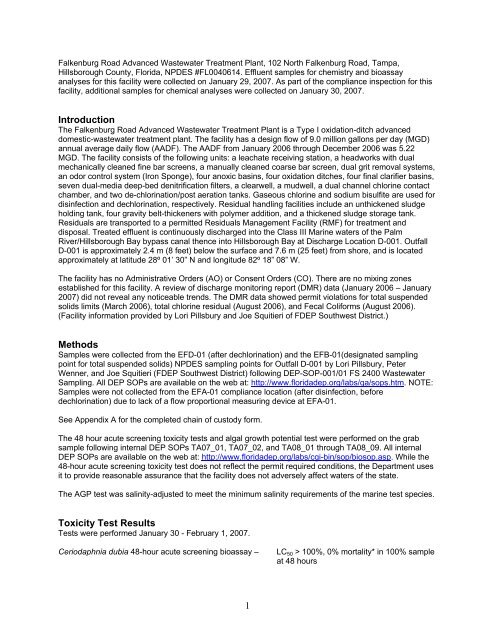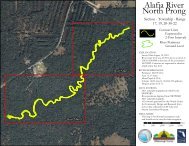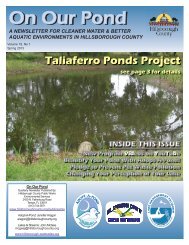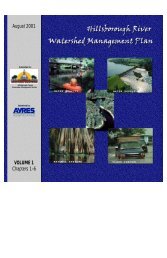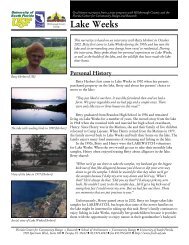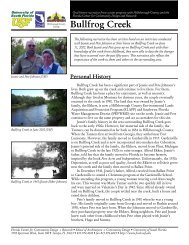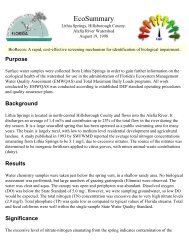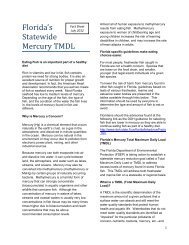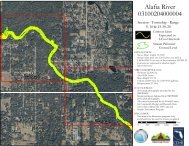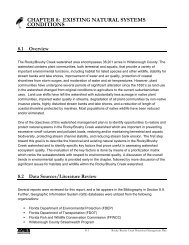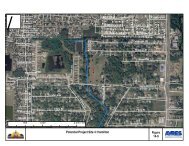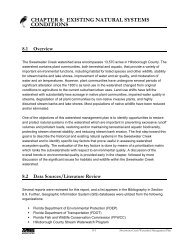Falkenburg Road Advanced Wastewater Treatment Plant
Falkenburg Road Advanced Wastewater Treatment Plant
Falkenburg Road Advanced Wastewater Treatment Plant
Create successful ePaper yourself
Turn your PDF publications into a flip-book with our unique Google optimized e-Paper software.
<strong>Falkenburg</strong> <strong>Road</strong> <strong>Advanced</strong> <strong>Wastewater</strong> <strong>Treatment</strong> <strong>Plant</strong>, 102 North <strong>Falkenburg</strong> <strong>Road</strong>, Tampa,Hillsborough County, Florida, NPDES #FL0040614. Effluent samples for chemistry and bioassayanalyses for this facility were collected on January 29, 2007. As part of the compliance inspection for thisfacility, additional samples for chemical analyses were collected on January 30, 2007.IntroductionThe <strong>Falkenburg</strong> <strong>Road</strong> <strong>Advanced</strong> <strong>Wastewater</strong> <strong>Treatment</strong> <strong>Plant</strong> is a Type I oxidation-ditch advanceddomestic-wastewater treatment plant. The facility has a design flow of 9.0 million gallons per day (MGD)annual average daily flow (AADF). The AADF from January 2006 through December 2006 was 5.22MGD. The facility consists of the following units: a leachate receiving station, a headworks with dualmechanically cleaned fine bar screens, a manually cleaned coarse bar screen, dual grit removal systems,an odor control system (Iron Sponge), four anoxic basins, four oxidation ditches, four final clarifier basins,seven dual-media deep-bed denitrification filters, a clearwell, a mudwell, a dual channel chlorine contactchamber, and two de-chlorination/post aeration tanks. Gaseous chlorine and sodium bisulfite are used fordisinfection and dechlorination, respectively. Residual handling facilities include an unthickened sludgeholding tank, four gravity belt-thickeners with polymer addition, and a thickened sludge storage tank.Residuals are transported to a permitted Residuals Management Facility (RMF) for treatment anddisposal. Treated effluent is continuously discharged into the Class III Marine waters of the PalmRiver/Hillsborough Bay bypass canal thence into Hillsborough Bay at Discharge Location D-001. OutfallD-001 is approximately 2.4 m (8 feet) below the surface and 7.6 m (25 feet) from shore, and is locatedapproximately at latitude 28º 01’ 30” N and longitude 82º 18” 08” W.The facility has no Administrative Orders (AO) or Consent Orders (CO). There are no mixing zonesestablished for this facility. A review of discharge monitoring report (DMR) data (January 2006 – January2007) did not reveal any noticeable trends. The DMR data showed permit violations for total suspendedsolids limits (March 2006), total chlorine residual (August 2006), and Fecal Coliforms (August 2006).(Facility information provided by Lori Pillsbury and Joe Squitieri of FDEP Southwest District.)MethodsSamples were collected from the EFD-01 (after dechlorination) and the EFB-01(designated samplingpoint for total suspended solids) NPDES sampling points for Outfall D-001 by Lori Pillsbury, PeterWenner, and Joe Squitieri (FDEP Southwest District) following DEP-SOP-001/01 FS 2400 <strong>Wastewater</strong>Sampling. All DEP SOPs are available on the web at: http://www.floridadep.org/labs/qa/sops.htm. NOTE:Samples were not collected from the EFA-01 compliance location (after disinfection, beforedechlorination) due to lack of a flow proportional measuring device at EFA-01.See Appendix A for the completed chain of custody form.The 48 hour acute screening toxicity tests and algal growth potential test were performed on the grabsample following internal DEP SOPs TA07_01, TA07_02, and TA08_01 through TA08_09. All internalDEP SOPs are available on the web at: http://www.floridadep.org/labs/cgi-bin/sop/biosop.asp. While the48-hour acute screening toxicity test does not reflect the permit required conditions, the Department usesit to provide reasonable assurance that the facility does not adversely affect waters of the state.The AGP test was salinity-adjusted to meet the minimum salinity requirements of the marine test species.Toxicity Test ResultsTests were performed January 30 - February 1, 2007.Ceriodaphnia dubia 48-hour acute screening bioassay –LC 50 > 100%, 0% mortality* in 100% sampleat 48 hours1


